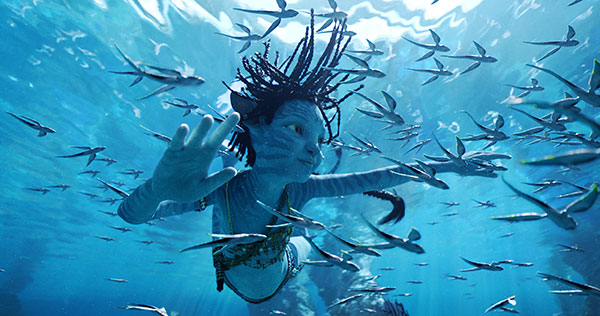James Cameron’s long-awaited blockbuster sequel, Avatar: The Way of Water, is a big, boisterous, beautiful return to Pandora.
James Cameron has a longstanding, boundary-pushing obsession with water. Whether it was the use of specially designed cameras in The Abyss (1989) or copious amounts of the liquid in Titanic (1997), Cameron’s fascination with water and his recognition of its epic beauty, incomprehensible mystery, and dangerous power recurs in his many of his films. Avatar: The Way of Water takes this deep affinity to the next level, and then some. The film was first scheduled for release in 2014, but had extensive delays due to Cameron’s desire to develop new technology in order to complete underwater motion capture filming. With three more films already planned for this sci-fi series, Avatar: The Way of Water might to some already feel like a repetitive trek back to the moon of Pandora, but Cameron’s second film justifies its existence thanks to its groundbreaking CGI and performance capture work.
Avatar: The Way of Water picks up some years after its predecessor. Jake Sully (an often-wooden Sam Worthington, Terminator Salvation) and Neytiri (the always emotive Zoe Saldaña, Guardians of the Galaxy) have four children and live a seemingly harmonious life with other Na’vi in the jungles of Pandora, although sporadic fighting with humans – the Sky People – highlights the fragility of this peaceful existence. Despite the decades-plus time jump, Avatar: The Way of Water treads a lot of the same ground as the first film. Humans are once more the antagonists – Stephen Lang’s Colonel Miles Quarith returns in a canny way – and destroy large swathes of Pandora’s nature, creatures are ridden by Jake and his family for the first time, and melodramatic deaths appear once more. Despite this repetitive nature, which seems to recycle tropes, themes and even plotlines from Avatar (2009), this sequel still feels refreshing thanks to its water-based setting and action.
After an initial attack by the Sky People on the jungle-dwelling Na’vi, Jake, Neytiri and their children seek safety with the Metkayina, a remote tribe of Na’vi who live in the distant shores and waters of Pandora. Perhaps the highlight of Avatar: The Way of Water is in this initial water-based section, as Jake’s family are shown, as the title suggests, the ‘ways of the water’ by this newly introduced tribe. Underwater motion capture has never been done before. The result, which is born out of years of work by hundreds of people and digital visual effects company Wētā FX, is spellbinding. In this sense, Avatar: The Way of Water feels as groundbreaking and as innovative as the first film did in 2009.

Fluid character movements (for the most part) give these water-based scenes a naturalistic flow befitting the liquid, and every bubble, ripple and wave dances and undulates with life on screen. Shooting these and some other land-based scenes in 48FPS (frames per second) occasionally gives a videogame sheen and slickness to proceedings, and the transition to the industry standard of 24FPS and back again to 48 can be jarring, but largely speaking, Avatar: The Way of Water is a technical achievement of the highest order. It is scarcely believable.
On the whole, Pandora dances with colour and verve. Intricate details in the background and foreground throughout every scene help build this spellbinding world, one deep with lore. Avatar: The Way of Water works best when it veers off into its tangents of exploration, when we follow the Na’vi characters as they marvel at and connect with the natural world. Foliage feels tangible and organically moves in the breeze, whilst rays of sunlight cast a mythical aura over Pandora.
When Avatar: The Way of Water moves more firmly into its narrative, the issues arise. Often simplistic and with little character development, the plot pits Na’vi against human again, and does very little more with that. Despite this, it is never dull. The glorious visuals, intense detail, and scintillating action ensure Avatar: The Way of Water is always tremendously engaging. The themes are solid, if a little thinly developed: messages of environmentalism are pleasant and genuinely affecting; other commentaries such as that on imperialism require more thought and depth, especially in the context of Jake’s origins, identity, and white saviour characteristics.
Despite the rather rote plot and Cameron’s cringey, schlocky script, the emotional beats of Avatar: The Way of Water still mostly resonate. They may not stick with you long after the credits roll, but the epic melodrama of it all will engross you whilst watching. The awe-inspiring CGI and staggering mocap will, however, stay with you long after the film concludes. Glorious vistas of the ocean or floating mountains and bright, colourful underwater sequences make this journey back to Pandora worthwhile. A breathtaking, thunderous finale highlights to us again that Cameron can still do nail-bitingly quick but and easy to follow action, whilst tantalising plotlines are set up for the next instalments. Despite its issues, Avatar: The Way of Water has reason and vigour behind its existence – will the third, fourth and fifth instalments be similarly justified too?
Avatar: The Way of Water will open globally in theaters on December 16, 2022.
